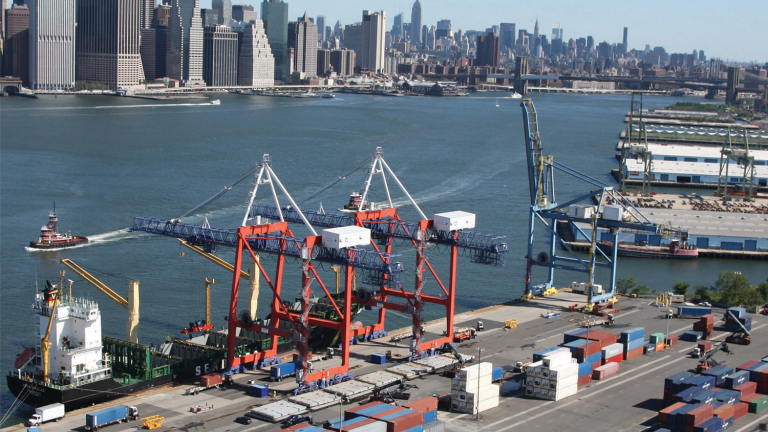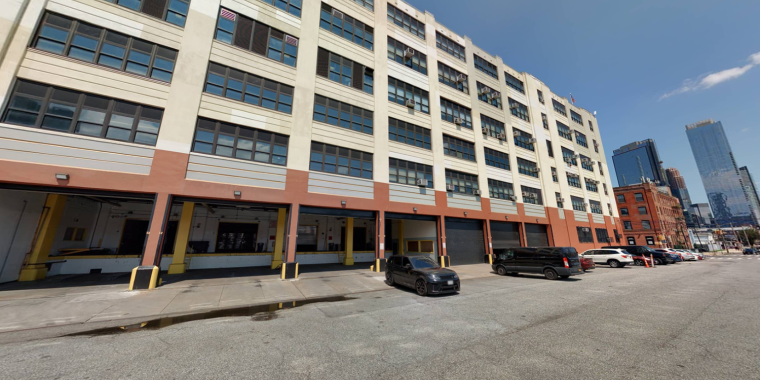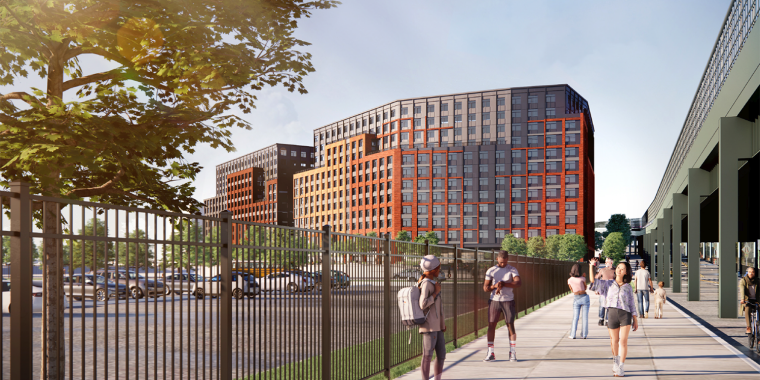
City Pledges $38 Million in New Funding to Support Water Freight and Sustainable Last Mile Solutions
“Delivering Green” Plan Lays Out Sustainable Vision to Reduce Overreliance on Diesel Trucks
NEW YORK, NY—Mayor Bill de Blasio, the New York City Department of Transportation (DOT), and the New York City Economic Development Corporation (NYCEDC) today released Delivering Green: A vision for a sustainable freight network serving New York City, a progressive vision to restructure freight distribution and reduce overreliance on diesel trucks.
Mayor de Blasio announced $38 million in new funding for freight programs. That funding includes $18 million for the new Blue Highways pilot program, a joint effort between DOT and EDC to spur private investments in marine vessels to transport goods into and around the city. The program also encourages the use of sustainable last mile delivery solutions like electric trucks and commercial cargo bicycles.
“For centuries, maritime freight was the core of New York City’s economy. Now, it’s time to re-engage the blue highway that can make deliveries safer, faster, and more sustainable,” said Mayor Bill de Blasio. “This report charts a real path forward for the future of a greener local economy – all while creating jobs and reducing traffic and pollution.”
“As our demand for freight continues to increase, we cannot continue the historic mistake of relying on more oversized and polluting diesel trucks to handle the load,” said DOT Commissioner Hank Gutman. “They destroy our infrastructure, damage the public health and quality of life in our neighborhoods, clog our already overcrowded streets and hasten climate change. We must change course. We have developed a thoughtful blueprint for the next five years to do just that. We are laying out a vision to reclaim New York City’s original highways — our harbor and rivers — to bring goods into the city and shifting to cargo bikes and other small, green vehicles to complete the journey to our doorsteps.”
“New York City simply cannot continue the status quo where 90% of goods move into and around the five boroughs on trucks. That’s why we’re focusing on ways to shift more freight traffic away from our crowded roads and bridges, and onto rail and our waterways,” said NYCEDC President and CEO Rachel Loeb. “This new vision with our partners at DOT lays out the bold steps the City will take to fundamentally restructure the freight distribution system. This will strengthen the economy by making freight movement more efficient and contribute to a healthier environment for all our residents and the planet.”
City officials were joined by Axel Carrion from UPS to make the announcement today on Pier 79, with the backdrop of a New York Waterways passenger ferry that will moonlight for freight use, and pair with innovative technologies to get goods to the doorstep sustainably.
Nearly 90% of the City’s goods are moved by truck, the result of the shift from rail and water networks to highways in the second half of the 20th century. The growing dependency on trucks to meet an increasing demand for goods exacerbates traffic congestion, pollutes air, stresses aging infrastructure, and harms quality of life in residential neighborhoods. Delivering Green offers concrete near-term and long-term tactics to reverse those trends and move goods by water, rail and by other more sustainable modes of transportation.
The administration also announced that the Red Hook Container Terminal has received nearly $1.5 million in federal grant funding from the U.S. Department of Transportation’s America’s Marine Highway Program. The funding will go toward vessel modifications that are needed to reduce the number of tractor-trailers on city roadways by placing more freight on barges. When implemented, this cross-harbor barge service will make one round trip per day, moving trailers between Brooklyn and Newark.
DOT estimates that truck traffic across the Hudson River has increased by over 50% between January 2020 and September 2021. Without action, the increase in freight demands will result in tens of thousands more trucks crossing into the city every day, while the city’s network of streets and bridges remains fixed. Such unchecked growth in truck delivery is simply untenable—for communities, streets, and the environment.
Delivering Green lays out five specific goals to fundamentally restructure freight distribution: encourage greener and more efficient truck deliveries; increase the share of goods moved by water, rail, and cargo bicycles; and support innovation and new technologies to make freight movement more efficient and compliant. The Delivering Green vision represents an outgrowth to earlier agency plans, including Delivering New York (DOT, May 2021) and FreightNYC (EDC, July 2018).
Delivering Green goals include:
Make the Last Mile More Efficient
Promote off-hour deliveries and expand Neighborhood Loading Zones. In addition, the plan promotes programs to consolidate the delivery of goods to one location for multiple recipients, and micro-distribution spaces where deliveries can be transferred to sustainable methods of transportation for the last mile to recipients.
Green the Last Mile
Support the transition to zero-emission truck fleets, help shift goods off trucks and onto commercial cargo bicycles, and explore other sustainable small delivery methods.
Create a Culture of Compliance
Seek federal funding to implement technology to improve truck rule compliance, while also bolstering industry education and outreach.
Shift Freight from Road to Water
Create opportunities for marine freight movement by modernizing marine terminals, expanding waterfront access to maritime shippers, and supporting private sector marine highway initiatives.
Shift Freight from Road to Rail
Increase diversion of freight from trucks to trains by expanding transload facilities in the city and modernizing key freight rail assets.
The Infrastructure Investment and Jobs Act recently enacted by Congress and signed into law by President Biden includes more than $120 billion in federal funding over the next five years for freight projects. New York City will soon have a once-in-a-generation opportunity to compete for federal funding on a size and scale that could have transformational impacts on how goods are moved into, out of, and around the five boroughs.
The City intends to seek federal funding for critical freight projects over the next five years and beyond. This funding will bolster funded efforts that are already underway. With the appropriate funding and support, the transformative freight solutions highlighted in the vision will have enormous impacts on freight mobility in New York City, putting the city on a path towards a safer, more responsible, sustainable, and efficient freight system that grows the economy, supports freight-related jobs, and delivers the goods that residents and businesses need.
“The New York region needs a better way to move goods, plain and simple. On this, there is overwhelming consensus. We must end our over-reliance on trucks that clog and destroy our roads, make the cost of doing business and consumer goods more expensive, harms our environment, raises childhood asthma rates, and creates safety and national security vulnerabilities. Today’s announcement of New York City’s freight vision, which will involve making key investments in maritime and rail infrastructure to create a sustainable distribution system is an important step in addressing this very serious problem. One such key investment, is the recent announcement by US Department of Transportation of a $1.5 million federal grant to the Red Hook Container Terminal (RHCT). This grant will enable RHCT to make modifications to their barges to move tractor trailers by barges between Brooklyn and Newark, and it is exactly the type of investment we must do to create a green and sustainable freight network for the 21st century,” said U.S. Rep. Jerry Nadler.
“It’s invigorating to see the City taking the bold steps necessary to transform freight distribution and create a sustainable system for making freight movement more efficient and greener,” said Assembly Member Jo Anne Simon. “In this era of rapidly advancing climate change, we need smart and environmentally-just transportation infrastructure. This important plan for innovation and investment in new freight movement technologies will result in improved quality of life for all New Yorkers.”
“Freight trucks produce massive amounts of emissions that impact predominantly black & brown communities, especially in my district. I hope that with this new initiative, we can begin to decrease our reliance on freight trucks,” said Council Member Ydanis Rodriguez, Chairman of the Transportation Committee. “If we wish to meet our carbon neutrality goal by 2050 we need to begin using our waterways, railways, and cargo e-bikes as alternatives to freight trucks. I thank Mayor de Blasio, DOT Commissioner Hank Gutman, and the advocates for working tirelessly to ensure our city is decreasing its reliance on freight trucks and embracing more sustainable modes of transportation."
"I’m proud to have worked with EDC and the Mayor to show that New York City is serious about combating climate change and making our streets safer. As online purchases have increased, trucking delivery services have choked our city streets. Spreading freight to the sea takes advantage of our navigable waters to promote reliable and alternative means of transporting goods," said Council Member Carlos Menchaca. "Not only will Southwest Brooklyn benefit from this new shift but also our economy and environment. Most importantly, I want to thank the advocates in Red Hook and Sunset Park including UPROSE, Southwest Brooklyn Industrial Development Corporation, PortSide New York, the Red Hook Initiative, Community Board 6 and 7 for leading the way and reminding the government of its duty to act for a better and cleaner New York City."
"It is crucial that New York City balances its transportation network with higher priority for freight. Many streets are being pushed to their limits, resulting in cars and trucks double-parking, which slows traffic and blocks bus lanes," said Liam Blank, Policy & Communications Manager for Tri-State Transportation Campaign. "We commend Mayor de Blasio and NYCDOT for this new initiative, which will help to reduce congestion, cut air pollution, and save lives."
“The goals outlined in the de Blasio administration’s Delivering Green framework are critical for modernizing the way New York City moves goods, and should be put into action as soon as possible. Too many of the city’s neighborhoods are overrun with truck deliveries, and transporting freight by water and rail – and by cargo bikes and smaller electric vehicles for the last mile – will improve health, reduce traffic congestion, and make streets safer,” said Eric McClure, Executive Director of StreetsPAC.
“As a community that’s facing unprecedented development of last-mile delivery facilities, Brooklyn CB6 is highly supportive of the goals outlined in Mayor de Blasio’s Delivering Green vision. Red Hook's waterfront is an ideal place to pilot delivery of goods by barge and ferry, and large-scale implementation of last-mile delivery by e-cargo bikes and other smaller electric vehicles will have multiple, and substantial, benefits for our neighborhoods. We’re ready to help put these plans into action as soon as possible,” said Mike Racioppo, District Manager, Brooklyn Community Board 6.
“Red Hook Container Terminal salutes the City of New York for focusing on strengthening its vital supply chain. Delivering Green meets the moment by addressing all aspects of the freight delivery system. Red Hook Container Terminal and our partner Hughes Marine are particularly proud to support the marine highway aspect of the vision plan. We are delighted that the Vision Plan strongly emphasizes the need to invest in our ports and waterways. The recently announced $1.5M grant we received from the USDOT Maritime Administration will allow us to reduce truck trips while supplying New Yorkers with the consumer goods they need to thrive in our wonderful city,” said Mike Stamatis, President and CEO, Red Hook Container Terminal, Inc.
"Rapid and unregulated growth in last mile fulfillment centers is an environmental justice issue. These massive facilities are concentrated in historically marginalized communities- add toxic air pollution and truck congestion to overburdened communities. UPROSE is encouraged to see the City's commitment to address these issues. For decades, frontline community-led solutions have called for clean marine & rail transportation to reduce the number of polluting diesel trucks from our communities. NYC must lead and be a true partner in operationalizing the community's vision for Green Re-Industrialization of our working waterfront,” said Elizabeth Yeampierre, Executive Director of UPROSE.
About NYCEDC
New York City Economic Development Corporation is a mission-driven, nonprofit organization that creates shared prosperity across New York City by strengthening neighborhoods and creating good jobs. We work with and for communities to bring emerging industries to New York City; develop spaces and facilities for businesses; empower New Yorkers through training and skill-building; and invest in sustainable and innovative projects that make the city a great place to live and work. To learn more about what we do, visit us on Facebook, Twitter, LinkedIn, and Instagram.


